There are around 49 different species of tortoise, but only a handful of these species are kept as pets. Each species is unique in their own way, and some make better pets than others. Although they aren’t the cuddliest of pets, tortoises still remain one of the most popular pet reptiles around the world.
Caring for a tortoise can be rewarding, especially when you watch them thrive and observe their fascinating behaviors. If you are willing to commit the next few decades of your life to caring for a tortoise, check out this list of the eight best species to choose from.
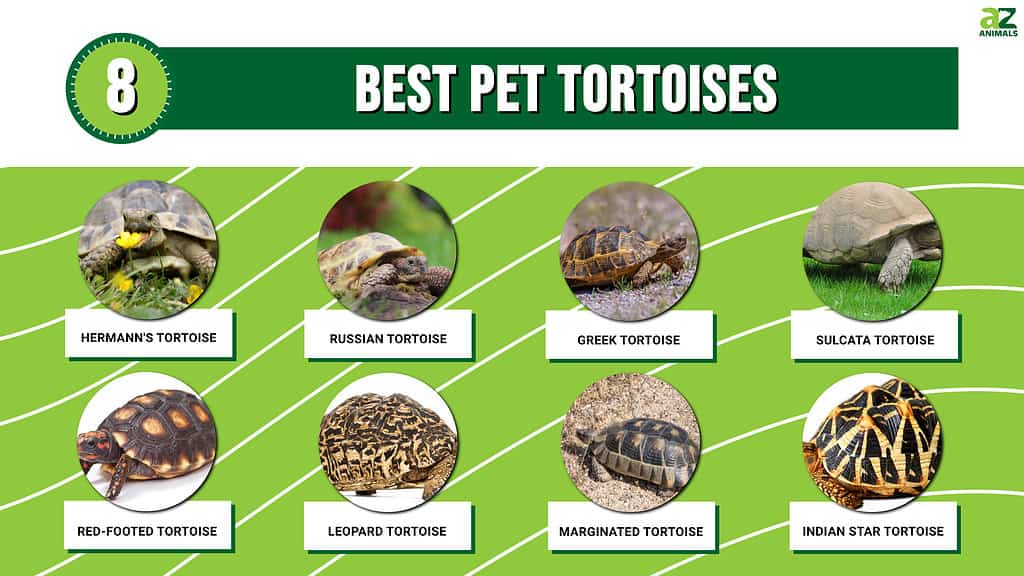
Factors to Consider Before Getting a Pet Tortoise
Before you or your child decide to get a tortoise, you need to determine if this reptile is the right pet for you.
Lifespan
Keep in mind that most species of tortoise can live well over 50 years, which is much longer than many people expect. Some owners may even need to add their tortoises to their will since they are capable of outliving you.
Cost
There is also the cost aspect to consider, since their supplies, food, and housing can be costly. Since most tortoises require a heating lamp and UV lighting during the day, you will likely have a higher electric bill each month.
If your tortoise is injured or ill, you will need to take him to an exotic veterinarian. This can be expensive, so you will need to set money aside each month for medical emergencies.
Behavior
Another factor to consider is a tortoise’s behavior. They are not cuddly pets, which is the main reason they do not make good pets for children. Most young children are not ready for the responsibility of caring for a tortoise, nor are they able to grasp just how long they will need to care for a tortoise.
Most tortoises do not enjoy human interaction and will not like to be handled or picked up. You cannot pick a tortoise up and let them sit on the couch with you, nor can you let them roam around the house.
The Best Pet Tortoises
If the above factors are not a problem for you, read up on the best species to choose from.
1. Hermanns Tortoise
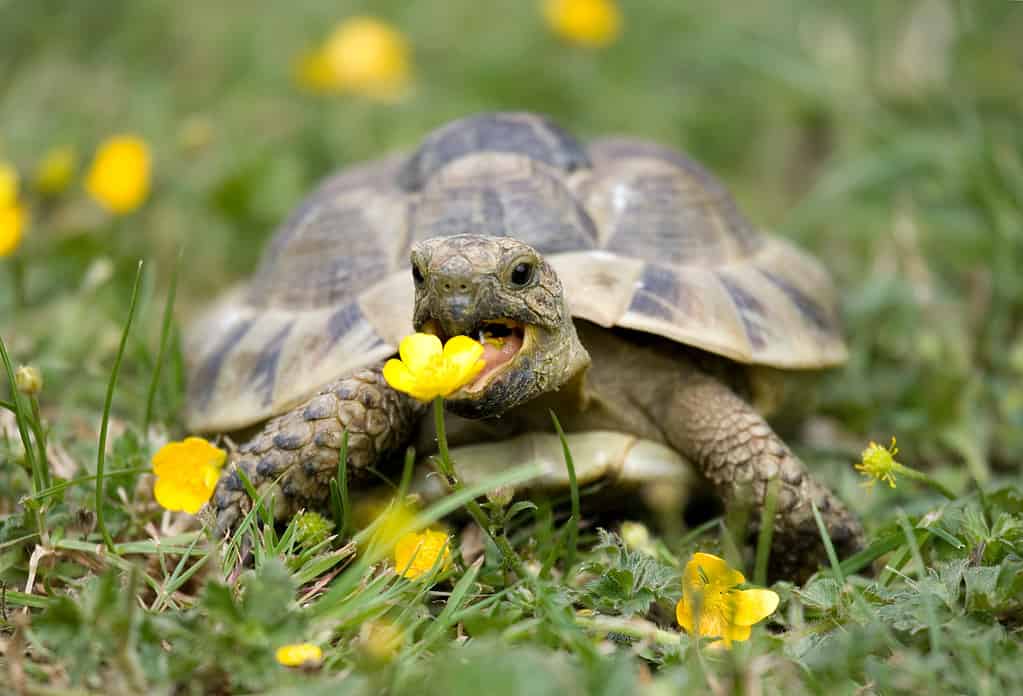
The Hermann’s tortoise is near threatened in the wild, and they exist in higher populations in captivity.
©chrisbrignell/Shutterstock.com
| Species name: | Testudo hermanni |
| Adult size: | 6 – 10 inches |
| Lifespan: | 30 – 75 years |
One of the most popular pet tortoises happens to be Hermann’s tortoise. They are a species of Mediterranean tortoise that can be found in two sub-species – the western and eastern Hermann’s tortoise. The western Hermann’s tortoise is slightly smaller and more colorful than the eastern Hermann, which is the more common species. However, you should not expect your Hermann tortoise to grow larger than 10 inches, with 8 inches being standard.
The Hermann’s tortoise is an herbivore that thrives on a diet of fresh fruits, veggies, and pellets. They are a relatively hardy species that can be kept either indoors or outdoors, but indoors is ideal. You will need to create a comfortable living space for your Hermann tortoise and ensure that they have proper heating and UV lighting during the day. They are fun to observe as they bask, forage, and explore their environment.
Unfortunately, Hermann’s tortoises are solitary in the wild, so it is better to avoid housing them with other tortoises for their own safety.
2. Russian Tortoise
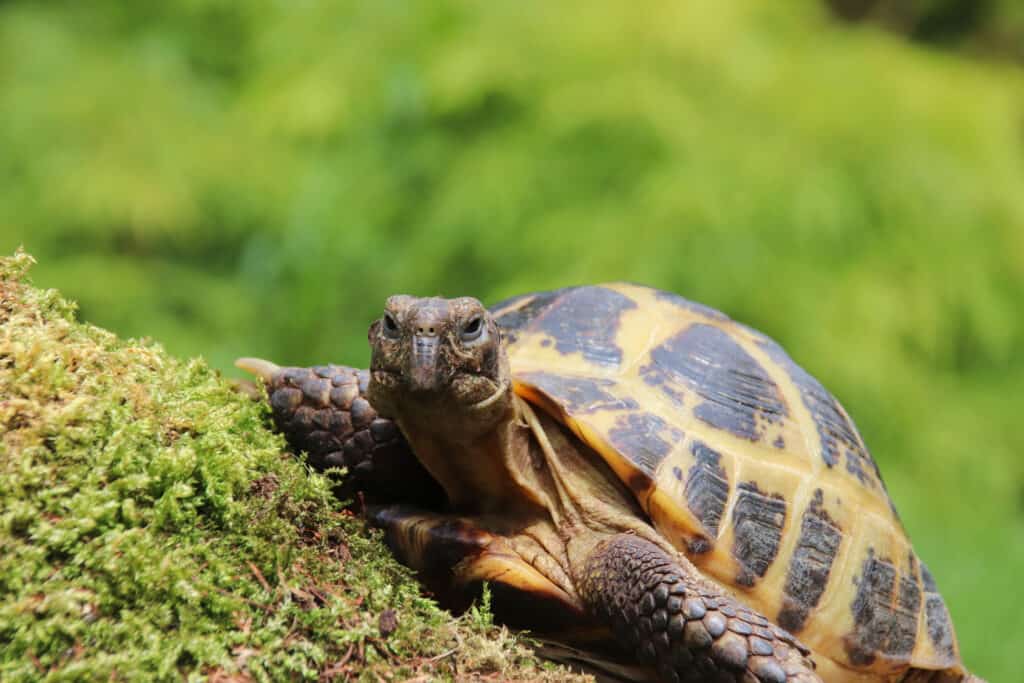
You should never keep different species of tortoise together if they do not live together in the wild.
©Haoss/Shutterstock.com
| Species name: | Testudo horsfieldii |
| Adult size: | 8 – 10 inches |
| Lifespan: | 50 – 80 years |
The Russian or Horsfield’s tortoise is a popular pet tortoise native to Central Asia. They are known for their active behavior, bright yellow bodies, and medium size.
Russian tortoises rarely exceed 8 inches in size and thrive in both indoor and outdoor enclosures. Most Russian tortoises are quite active during the day, which is ideal if you want a pet tortoise that you can see often.
They enjoy looking for food, digging in sand, and feeding on leafy greens. As herbivores, Russian tortoises enjoy collard greens, endive, kale, and turnip greens as a daily snack. They graze on different leafy greens throughout the day but still benefit from pellets.
While Russian tortoises may have their moments of mild aggression, they can be kept in groups provided that their enclosure is large enough. However, you should never keep them with other species of tortoise even if they are the same sex and are relatively healthy.
3. Greek Tortoise
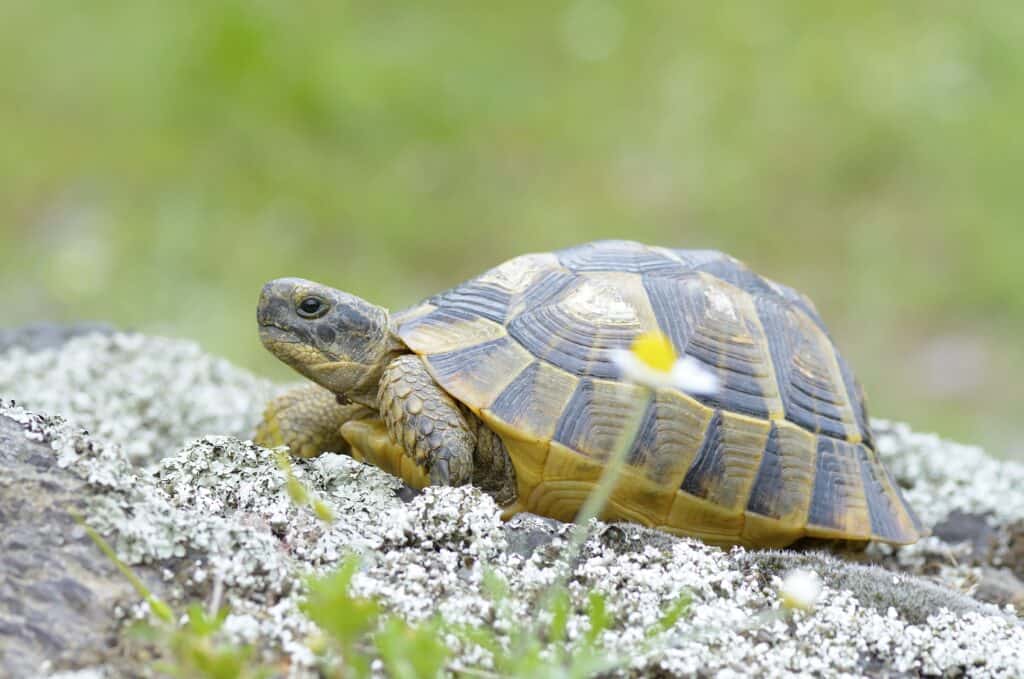
The Greek tortoise has spurs on their thighs, hence their second common name.
©iStock.com/Remus86
| Species name: | Testudo graeca |
| Adult size: | 5 – 11 inches |
| Lifespan: | 80 – 100 years |
The Greek or spur-thighed tortoise is a species of Mediterranean tortoise that is known for their longevity. Like most species of tortoise, the Greek tortoise can live for up to 100 years, and sometimes even longer.
They are not very big tortoises and only grow to around 5 to 11 inches in size. Greek tortoises are named after the Greek mosaics that are seen in their light yellow- and tan shells. They are not actually from Greece, but rather from North Africa, and parts of Europe and Asia.
They are relatively easy to care for and their dietary needs are similar to other Mediterranean tortoises. Greek tortoises thrive on an herbivorous diet of leafy greens, pellets, fruits, and soft veggies. They can be highly active when their environment is ideal and enjoy having a large enclosure to explore.
Although you can raise Greek tortoises indoors, they prefer being outdoors with natural sunlight. However, their enclosures need to be safe from predators. The Greek tortoise will appreciate having live and edible plants that they can snack on throughout the day, although fake plants still help create a natural environment for them.
While a group of female Greek tortoises might get along in the right environment, males can be territorial. You should never house Greek tortoises with other species from different wild locations, even if they seem friendly enough.
4. Sulcata Tortoise
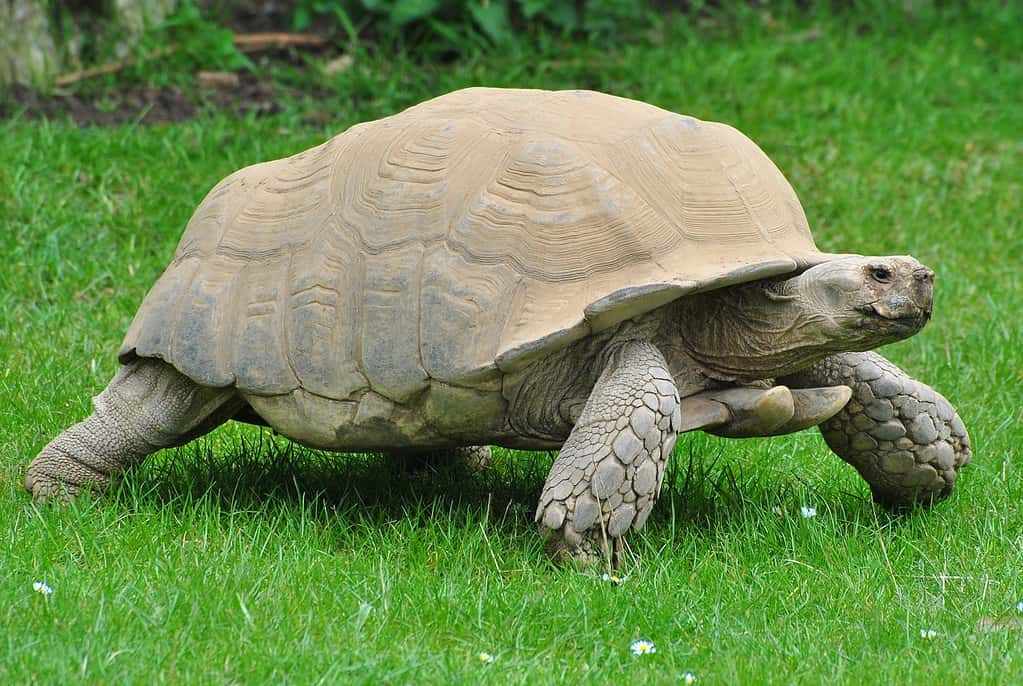
An adult sulcata tortoise can weigh as much as 150 pounds.
©John5199, CC BY 2.0, via Wikimedia Commons – License
| Species name: | Centrochelys sulcata |
| Adult size: | 20 – 30 inches |
| Lifespan: | 80 – 100 years |
The sulcata is one of the largest species of pet tortoise, growing up to 30 inches in size. Therefore, they only make good pet tortoises for people who can meet their housing needs. They are not recommended for beginners because they grow quickly and need very big outdoor enclosures.
Sulcata tortoises are often sold at a very small size in pet stores, but they can quickly grow into a 150-pound plus adult. They need very large outdoor enclosures as an adult and warm and humid indoor ones as a hatchling. Although they can be kept in groups, this can be difficult due to their space requirements.
Sulcata tortoises originate from the Sahara Desert, in Northern Africa, and from the arid grasslands of the Sahel. In captivity, adult sulcata tortoises thrive in a dry setup. They enjoy a sandy substrate mixed with cypress mulch and bark for moisture.
Hatchling or juvenile sulcata tortoises benefit from moss in their enclosure for humidity. The humidity will help keep their shell smooth and prevent dehydration.
Sulcata tortoises are herbivores and eat a lot of food as an adult. They need to be fed large portions of plant foods like weeds, grasses, hays, flowers, and collard greens daily. You should also include a pellet food once or twice a week to keep their diet varied.
5. Red-Footed Tortoise
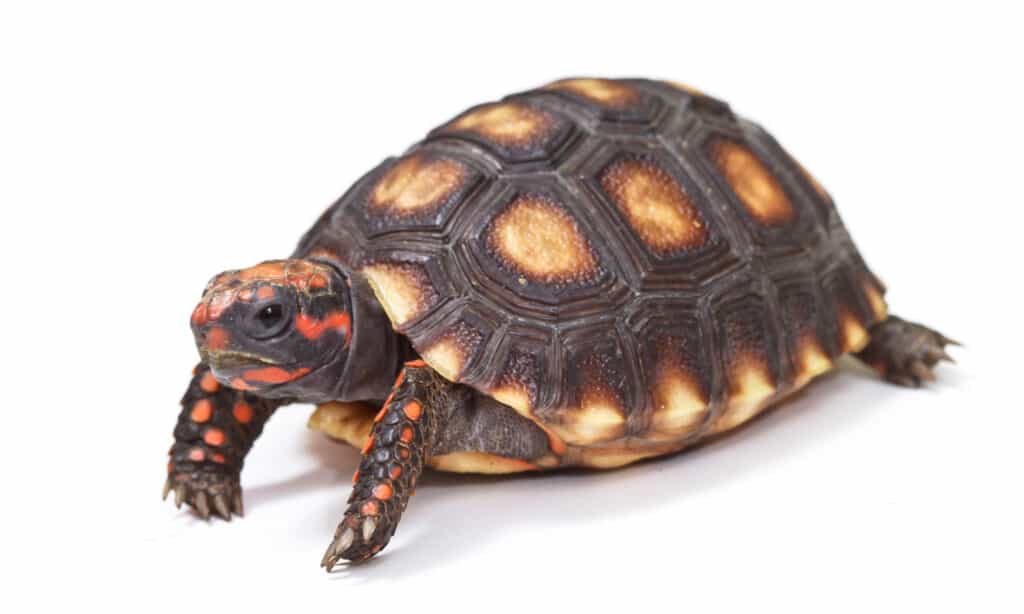
Red-footed tortoises will eat insects in the wild, so they are omnivores.
©bluedog studio/Shutterstock.com
| Species name: | Chelonoidis carbonarius |
| Adult size: | 12 – 16 inches |
| Lifespan: | 80 – 100 years |
The red-footed tortoise is native to northern South America and can be distinguished by the bright red markings on their face and legs. Red-footed tortoises benefit from a big enclosure filled with live plants and a moisture-rich substrate.
Humidity is important for red-footed tortoises as they are used to the humidity range in tropical climates. Substrates like soil, moss, and cypress mulch are ideal for red-footed tortoises because they retain more moisture. You will need to ensure that red-footed tortoises have a heated and warm enclosure that is regularly misted throughout the day to prevent it from drying out.
In the wild, red-footed tortoises will eat various fruits and leafy greens, but occasionally insects. They are omnivores that can handle more fruit in their diet than other species. Red-footed tortoises also enjoy eating beetles, worms, or crickets. However, any insects that you feed to them have to be from a pet store and free from parasites to avoid harming your red-footed tortoise.
Overall, the red-footed tortoise is an active and fun pet with many interesting behaviors.
6. Leopard Tortoise

Some species of tortoise can live for over 100 years, making them a lifelong commitment.
©Eric Isselee/Shutterstock.com
| Species name: | Stigmochelys pardalis |
| Adult size: | 16 – 26 inches |
| Lifespan: | 50 – 100 years |
Leopard tortoises can be found throughout Southern Africa, but they also make popular pet tortoises. They are named after the leopard patterns that adorn their shells. Most leopard tortoises grow between 16 to 18 inches in size, although it’s possible for them to reach 28 inches in size.
Caring for a leopard tortoise is pretty straightforward, and they often form bonds with their owners with regular interaction. However, this interaction is not through handling, but instead through feeding and observation. Leopard tortoises do not like being touched or picked up. They are a friendly species of tortoise that are not known for being territorial, so they can be kept in groups.
Leopard tortoises require a fibrous diet of different grasses, fruits, vegetables, and leafy greens. You will also need to supplement their diet with calcium to prevent shell deformities, especially while they are still growing. Humidity is vital for your leopard tortoise’s shell and overall health, so you will need to regularly mist their enclosure.
7. Marginated Tortoise
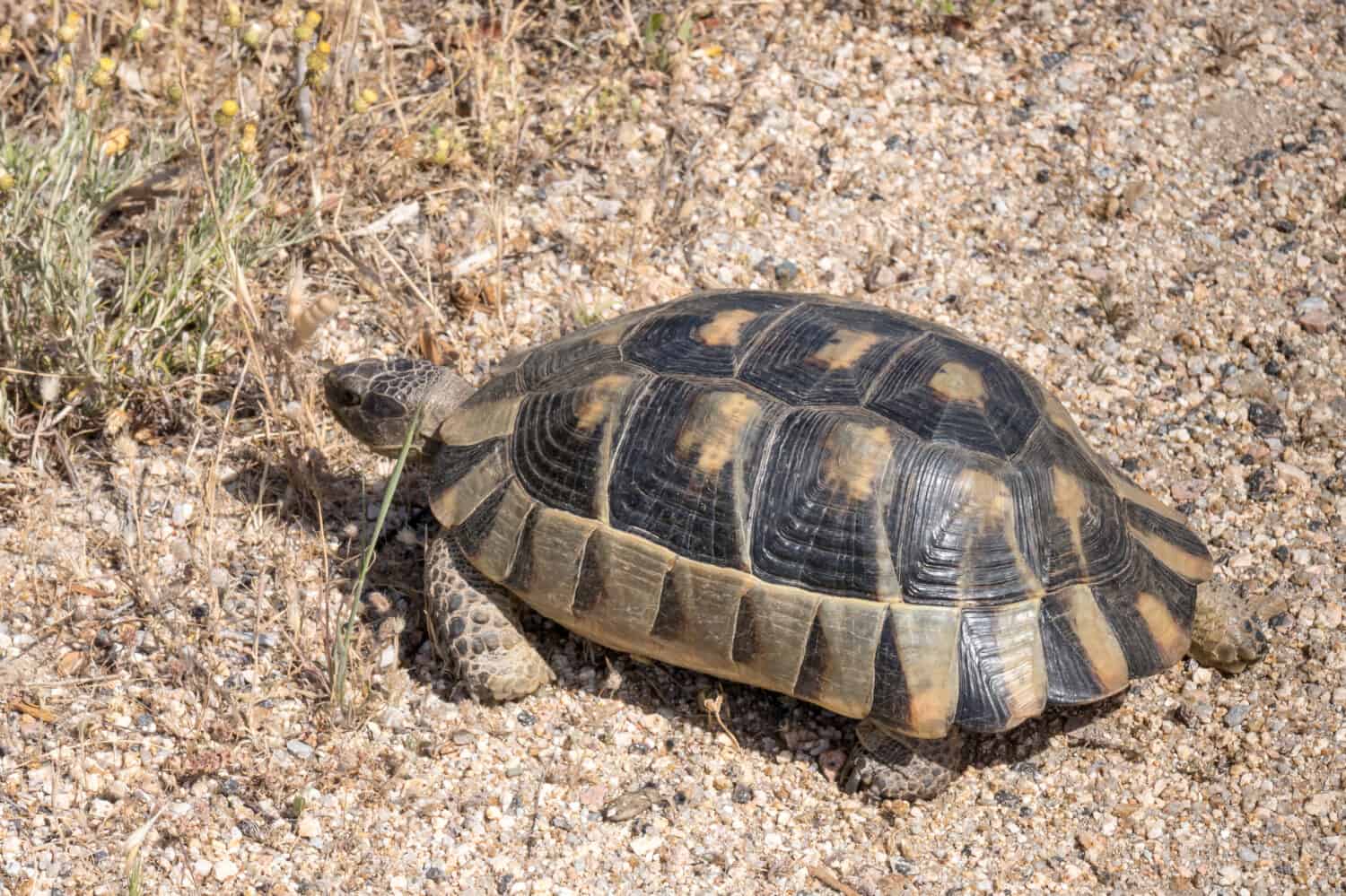
The flared shell of the marginated tortoise is easily distinguishable in adults.
©Philip Bird LRPS CPAGB/Shutterstock.com
| Species name: | Testudo marginata |
| Adult size: | 10 – 14 inches |
| Lifespan: | 75 – 100 years |
The marginated tortoise is native to Italy, Greece, and Southern Europe. They are one of the largest species of European tortoise that has a very long lifespan. Marginated tortoises only reach an adult size of 14 inches, but 12 inches is common for the species.
The marginated tortoise is known for their dark oval-shaped shells which flare at the end. Like most pet tortoises, marginated tortoises are strict herbivores that should be eating a mixture of leafy greens and veggies in their diet. You can get your marginated tortoise to interact with you more by offering them leafy greens from your hands. However, it is still fun to watch marginated tortoises explore and eat without having to handle them.
You can house your adult marginated tortoise either indoors or outdoors, as long as its enclosure is safe. It is crucial to keep marginated tortoises in a spacious and enriched enclosure. They benefit from either outdoor or indoor enclosures that offer them plenty of space to explore since they are active species. It is common for male marginated tortoises to be territorial as they start to mature, so they shouldn’t be kept in groups or with other species.
8. Indian-Star Tortoise

Indian star tortoises have striking intricate patterns along their shells.
©Mathee Suwannarak/Shutterstock.com
| Species name: | Geochelone elegans |
| Adult size: | 7 – 12 inches |
| Lifespan: | 50 – 80 years |
The final best pet tortoise on our list is the Indian star tortoise. This species of tortoise is native to India and Sri Lanka where they inhabit the arid forests and deserts. Indian star tortoises prefer a hot and humid environment consisting of sandy substrates, grasses, and edible live plants. It is best to replicate their natural habitat as much as possible in captivity to allow this species to thrive.
You can expect an Indian star tortoise to reach 12 inches in size as an adult. They are not very large species of tortoise, but they are one of the most attractive ones. Indian star tortoises have striking yellow and brown shells with star-like patterning. Their shell forms a dome that accentuates the vivid yellow or dark tan patterns.
Indian star tortoises benefit from a large enclosure that consists of a sandy or loamy substrate. You will need to mist their substrate daily to keep the humidity at an ideal level while ensuring that their enclosure is kept heated and maintained. Indian star tortoises are strict herbivores and enjoy a diet rich in leafy greens like dandelion, grass, hay, and endive. It is also important to supplement your Indian star tortoise’s diet with calcium for proper shell development.
Unlike many other species of tortoise, this species isn’t fond of digging. They prefer to explore their environment, graze on fresh foods, and bask in sunlight for warmth.
In Conclusion – Which Is the Best Pet Tortoise?
Each of these species of tortoise can be a good pet for different individuals. However, the Hermanns and Russian tortoises seem to make the most popular pet tortoises. The best pet tortoise for you will depend on your personal preference since tortoises can vary in size, temperament, behavior, and color.
It is recommended to research the species of tortoise you want before getting one. Tortoises can look cute in pet stores when they are small, but some species are capable of growing up to 30 inches in size. Remember, they are a lifelong commitment and require specific housing and supplemental heat to thrive.
Summary of the 8 Best Pet Tortoises
| Rank | Tortoise Name | Species Name | Adult Size | Lifespan |
|---|---|---|---|---|
| 1 | Hermanns tortoise | Testudo hermanni | 6 – 10 inches | 30 – 75 years |
| 2 | Russian tortoise | Testudo horsfieldii | 8 – 10 inches | 50 – 80 years |
| 3 | Greek tortoise | Testudo graeca | 5 – 11 inches | 80 – 100 years |
| 4 | Sulcata tortoise | Centrochelys sulcata | 20 – 30 inches | 80 – 100 years |
| 5 | Red-footed tortoise | Chelonoidis carbonarius | 12 – 16 inches | 80 – 100 years |
| 6 | Leopard tortoise | Stigmochelys pardalis | 16 – 26 inches | 50 – 100 years |
| 7 | Marginated tortoise | Testudo marginata | 10 – 14 inches | 75 – 100 years |
| 8 | Indian star tortoise | Geochelone elegans | 7 – 12 inches | 50 – 80 years |
The photo featured at the top of this post is © EcoPrint/Shutterstock.com
Thank you for reading! Have some feedback for us? Contact the AZ Animals editorial team.






